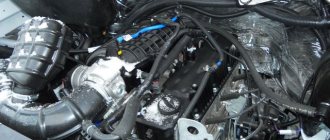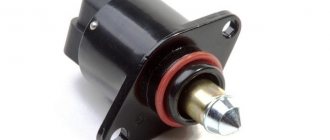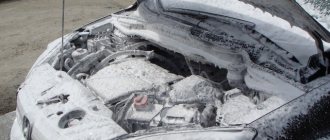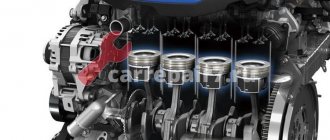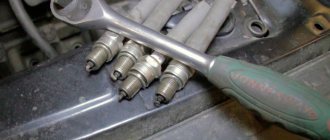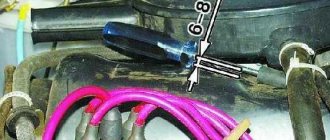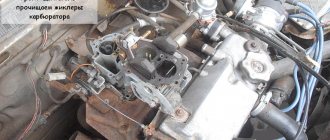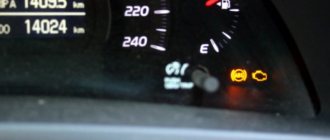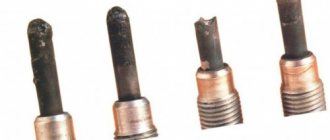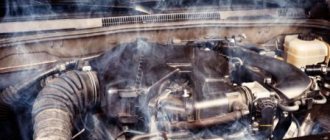Specifications
Before we begin to directly consider the issue of a malfunction associated with the tripping and blinking “CHECK” on the dashboard of a Gazelle Business car, it is worth considering the technical characteristics of the UMZ 4216 power unit:
| Name | Characteristic |
| Type | Row |
| Fuel | Petrol |
| Injection system | Injector |
| Volume | 2.9 liters (2890 cm3) |
| Power | 123 horsepower |
| Number of cylinders | 4 |
| Cylinder diameter | 100 mm |
| Consumption | 11 liters per 100 km |
| Cooling system | Liquid, forced |
| Econorm | Euro-3 |
Malfunction and solutions
The reasons for the occurrence of tripping and blinking “Check” are almost identical for all power units. The root cause may be improper formation of the air-fuel mixture or a breakdown in the ignition system. But, everything is in order.
Poor quality fuel
Low-quality gasoline, or in common parlance - “bad gas”, leads to the fuel supply elements becoming clogged, and the injection system itself forms a lean mixture. To diagnose and troubleshoot the problem, it is necessary to test the injectors. It is better to carry out this entire operation on a special stand. If it turns out that the elements are clogged, then we can say that the vehicle was operated on low-quality fuel.
Another reason could be a clogged fuel filter, which is recommended to be changed every 20,000 km. Also, it is worth examining the performance of the fuel pump, which may fail.
Ignition system
Breakdowns in the ignition system, namely malfunction of spark plugs, high-voltage wires and ignition coils, can lead to a tripping effect. So, you need to unscrew the spark plugs and inspect them for defects. Also, using a simple tester, measure the resistance of the high-voltage wires, which is 5 ohms.
Air supply
The formation of the air-fuel mixture is influenced by the state of the air supply. A clogged air filter element or throttle valve can cause a rich mixture, which can cause a tripping effect. To eliminate the malfunction, it is necessary to dismantle and inspect the elements.
If the air filter is clogged, it is recommended to replace it, but the throttle valve must be cleaned with a special product or liquid for cleaning carburetors.
Software problem
Repeatedly, the cause of the tripping and blinking “Check” is a malfunction of one of the sensors or accumulated errors inside the electronic engine control unit. So, it is necessary to diagnose the condition of the elements and replace damaged ones.
Troubleshooting methods
Once the root causes have been identified, troubleshooting can begin. Before we begin, it is worth noting that not all motorists are able to understand and fix the problem. So, it is necessary to have certain knowledge in the design of cars, as well as be able to diagnose correctly.
Therefore, it is strongly recommended that if a car enthusiast is not confident in his abilities, he should contact a specialized car service center, where professional workers can quickly and efficiently fix the problem. Well, those who decide to try it themselves should be patient.
Poor quality fuel
The power unit is malfunctioning, most likely due to low-quality fuel that has clogged the entire system. So, to solve the problem it is necessary to clean the entire fuel line and fuel tank. It is also recommended to check the injectors and fuel filter. After repairs, fill only with high-quality fuel at proven fuel stations.
Sensor malfunction
Another common problem is faulty engine sensors. Thus, the output of one or more measuring elements can lead to the motor starting to trip, which is very unpleasant. In this case, an increase in consumption will be observed. Therefore, to diagnose meters, it is worth stocking up on a multimeter, with the help of which the performance of the elements will be determined.
So, let's look at which sensors will affect engine operation:
- The first meter that is worth diagnosing is the temperature sensor. It is this element that most often fails. So, if it has been determined that the meter has failed, it must be replaced.
- In addition to the temperature sensor, it is worth paying special attention to the performance of the idle speed sensor and the throttle position sensor. These meters directly affect the operation of the engine and the production of the air-fuel mixture.
- The following elements are not so important, but they also need to be checked: oxygen sensor, mass flow sensor, crankshaft and valve timing sensor.
Fuel system malfunction
A malfunction of the fuel system directly affects the air-fuel mixture, and therefore this system should be checked carefully. Firstly, clogged injectors can affect fuel delivery. These elements are cleaned at a special stand, but many car enthusiasts do this on their own and not always successfully. If necessary, the nozzle should be replaced.
Secondly, it is worth checking the operation of the fuel pump, which may not pump fuel due to a clogged filter mesh. It is also recommended to change the fuel filter. After this, you can proceed directly to diagnosing the remaining elements.
Air supply
Like fuel, air plays an important role in the formation of the air-fuel mixture. Therefore, air supply diagnostics should be carried out on the same basis as the fuel system. Particular attention should be paid to the throttle valve. Clogging of this element can disrupt the balance of the air-fuel system, which causes tripping. The element is cleaned using a special liquid or spray for cleaning the carburetor.
Also, don't forget about the air filter. A clogged element does not allow enough air into the combustion chambers, which causes tripping. The element must be replaced every second maintenance, but no later than 30,000 km.
Ignition system
Another system that will affect the operation of the power unit is the ignition system. If one or more spark plugs malfunction, the engine does not receive a spark into the combustion chamber, and accordingly, not all cylinders work. Diagnosis of spark plugs is quite simple.
They are inspected for damage, oiliness and checked at a special stand or using the “old-fashioned” method, which is known to almost all car enthusiasts. High-voltage wires play an important role, which should also be checked for functionality and resistance.
Mechanics
The worst case scenario in which the engine fails is a malfunction of mechanical parts. Thus, burnout of valves and pistons will lead to unstable engine operation. Also, this is the first sign that the power unit requires major repairs. To diagnose, it is necessary to dismantle the cylinder head, which will show the condition of the piston group and valves.
ECU diagnostics
In order to understand which of the sensors or components affected the unstable operation of the engine, it is worth conducting a comprehensive diagnosis of the on-board computer. This requires an OBD II cable, a tablet and laptop, and software.
It is recommended to turn to professionals for help, who will quickly and efficiently perform diagnostic operations and fix the problem.
Deciphering error codes
If the car owner nevertheless decides to fix the problem on his own, then he will need to decipher the error codes that will appear on the diagnostic computer screen. So, let's look at all the error codes and their interpretation for the UMZ 4216 engine:
| DTC | Description |
| P0105 | Incorrect air pressure sensor signal |
| P0107 | Low signal level from air pressure sensor |
| P0108 | High signal level from the air pressure sensor, |
| P0122 | Low signal level from throttle position sensor (1 track) |
| P0123 | High signal level from the throttle position sensor (1 track) |
| P0112 | Low signal level from air temperature sensor |
| P0113 | High signal level from the air temperature sensor |
| P0115 | Incorrect signal from the coolant temperature sensor |
| P0117 | Low signal level from the coolant temperature sensor |
| P0118 | High signal level from the coolant temperature sensor |
| P0130 | No activity of oxygen sensor No. 1 |
| P0131 | Low signal level from oxygen sensor No. 1 |
| P0132 | High signal level from oxygen sensor No. 1 |
| P0133 | Oxygen Sensor #1 - Slow Response |
| P0135 | Open circuit of oxygen sensor heater No. 1 |
| No. 1 oxygen sensor heater circuit short to ground | |
| Short to power in the oxygen sensor heater circuit No. 1 | |
| P0137 | Low signal level from oxygen sensor No. 2 |
| P0138 | High signal level from oxygen sensor No. 2 |
| P0141 | Open circuit of oxygen sensor heater No. 2 |
| Short to ground circuit of the heater of the oxygen sensor Lg "2 | |
| Short to power in the oxygen sensor heater circuit No. 2 | |
| P0201 | Broken injector of cylinder 1 |
| Ground fault in cylinder 1 injector | |
| Short circuit to power supply of injector 1 cylinder | |
| P0202 | Broken injector of cylinder 2 |
| Injector 2 cylinder short to ground | |
| Short circuit to power supply of injector 2 cylinders | |
| P0203 | Broken injector cylinder 3 |
| Injector 3 cylinder ground short | |
| Short circuit to power supply of injector 3 cylinders | |
| P0204 | Broken injector 4 cylinders |
| Injector 4 cylinder ground short | |
| Short circuit to power injector 4 cylinders | |
| P0217 | Engine temperature is above the maximum permissible |
| P0219 | Engine speed is above the maximum permissible |
| P0221 | Range limit of the difference between 1 and 2 tracks of TPS |
| P0222 | Low signal level from throttle position sensor (2 track) j |
| P0223 | High signal level from the throttle position sensor (2 track) j |
| Open circuit of the fuel relay | |
| P0230 | Fuel relay primary circuit short to ground |
| Fuel relay primary circuit short to power | |
| P0301 | Misfire in cylinder 1 |
| P0302 | Misfire in cylinder 2 |
| P0303 | Misfire in cylinder 3 |
| P0304 | Misfire in cylinder 4 |
| P0327 | Low signal level from knock sensor |
| P0339 | HF Sync Sensor Synchronization Error |
| P0335 | HF synchronization sensor break |
| P0341 | Phase sensor synchronization error |
| P0351 | Broken ignition coil 1 |
| P0352 | Broken ignition coil 2 |
| P0420 | Low efficiency of the exhaust catalyst |
| Open circuit of the canister purge valve | |
| P0443 | Short circuit to ground in the canister purge valve circuit |
| Short circuit to power in the canister purge valve circuit | |
| Cooling fan relay primary circuit open | |
| P0480 | Cooling fan relay primary circuit short to ground |
| Cooling fan relay primary circuit short to power | |
| P0501 | Broken vehicle speed sensor |
| • | Idle air control malfunction | |
| P0505 | Open circuit of the idle speed regulator |
| Idle air control circuit short to power | |
| P0563 | High on-board voltage |
| P0562 | Low on-board voltage |
| P0603 | Control unit EEPROM error |
| P0604 | Control unit external RAM error |
| P0605 | Error in the external ROM of the control unit (ROM1) |
| P0606 | Control unit initialization error |
| Open circuit of the CHECK ENGINE lamp | |
| P0650 | Short circuit to ground in the CHECK ENGINE lamp circuit |
| Short to power in the CHECK ENGINE lamp circuit | |
| P1107 | Low signal level from the barocorrection sensor |
| P1108 | High signal level from the barocorrection sensor |
| P1122 | Low signal level from the accelerator pedal position sensor (1 track) |
| P1123 | High signal level from the accelerator pedal position sensor (1 track) |
| P1221 | Range limit of the difference between 1 and 2 accelerator pedal tracks |
| R.1222 | Low signal level from the accelerator pedal position sensor (track 2) |
| P1223 | High signal level from the accelerator pedal position sensor (track 2) |
| . Open circuit of the main relay primary circuit | |
| P1230 | Main relay primary circuit short to ground |
| Short to power in the primary circuit of the main relay | |
| Break in the primary circuit of the starter interlock relay | |
| P1330 | Starter interlock relay primary circuit short to ground |
| Short to power in the primary circuit of the starter interlock relay | |
| P1351 | Ignition coil 1 short circuit |
| P1352 | Ignition coil 2 short circuit |
| Open air conditioner relay primary circuit | |
| P1530 | Air conditioner relay primary circuit short to ground |
| Air conditioner relay primary circuit short to power | |
| P1570 | Open circuit of communication with immobilizer |
| P1606 | Low signal level from rough road sensor |
| P1607 | High signal level from rough road sensor |
| P1612 | Control unit reset error |
The engine heats up and starts to stall: why does this happen?
Almost every car enthusiast sooner or later encounters such a fairly common malfunction of the internal combustion engine, when the engine stalls. As a rule, in certain situations the engine stalls when hot or only when cold, and tripping can also occur constantly (regardless of the temperature of the power unit, operating mode, load level, etc.).
In short, engine tripping means that one or more cylinders are not firing, and there can be several reasons for such a malfunction. In this article we will talk about why the engine stalls after warming up, how the malfunction can be diagnosed, and what signs help to accurately identify the problem.
Read in this article
The engine is shaking!
Reasons why the engine may stall!
Hello dear friends! Today we will look at one, as it turns out, sore subject. Why is it sick, because, again, they helped to understand the search phrases, I often come across such as: the engine is trembling, the engine is troubling, the reasons why the engine is troubling, why the engine can be troubling , etc., etc. There are several reasons why the engine may fail. Let's take it one by one. Today we will discuss the topic of “ engine trouble” specifically in the example of gasoline engines, well, in particular, again, let’s take the ZmZ-511 engine. And the reasons that the engine is tripping are approximately the same for gasoline engines, only the difference is in the design of the engines.
First of all, of course, let's take the spark plugs. What kind of spark plugs should I put on the ZmZ-511 engine so that the engine can work normally? Yes, of course, there are different spark plugs, but for ZmZ-511 engines and modifications you need to install A11 . Why A11 candles, and not A14 or A17 , because candles have their own heat number, but you can find out in detail what a heat number is here. So don’t be confused, but there are some: “Who cares, I’ll put it in, any will do,” no, it won’t, so I say A11 , well, if there’s nothing to put in at all, then you can also A14 , but be sure to change it at the first opportunity on A11. And I don’t recommend installing A17 Because of them, the engine may very well stall as soon as you install it.
What else can you say about candles? Like all parts and consumables, candles also have their own service life. Modern spark plugs last up to 30 thousand km, and some even more, up to 60 thousand km. There are spark plugs with a pure silver central electrode, the declared resource of which is around 50 thousand km. - these indicators are stated by the manufacturer; in practice, the service life of the spark plug depends not only on the quality of the fuel, the condition of the engine and driving style, but also on the materials of the spark plug itself. On worn-out engines, a slightly larger amount of oil enters the cylinders than necessary; accordingly, more carbon deposits form on the spark plug electrodes, which leads to a decrease in the service life of the spark plugs and interruptions in engine operation. Malfunctions in the cooling system lead to overheating of the engine and, as a consequence, to disruption of the heat removal mode from the spark plugs; they overheat excessively, the electrode materials lose their properties, which leads to early “aging” of the spark plugs and their premature failure. So change your spark plugs when needed. And yet, it is best to use domestically produced candles, they are available for sale. Here's an example.
Secondly, you will need to check the spark plug wires, spark plug tips, slider, and ignition distributor cap (distributor). It could be that they were pierced by a spark. And the spark, accordingly, will not be supplied to the spark plugs, but will break through somewhere to ground. And here you go, the engine starts. Let's check them in order. Check the slider first. If the slider is broken, there will be a mark from it.
The trace from the penetration is similar to the trace that lightning leaves in the sky during a thunderstorm. In case anyone doesn’t know, a spark is a huge volt of electricity (if I wrote something wrong, I apologize, I’m not an electrician). If my memory serves me correctly, the value in volts can range from 12,000 to 24,000 volts.
But usually the slider hits the rotor of the ignition distributor (distributor). In this case, it is impossible not to see it, that is, where it is broken, it remains to be replaced. And of course, if you have a slider with a resistor to eliminate radio interference, then you need to check whether the resistor is intact.
Now check the distributor cap. Usually, when a spark breaks through the lid, the same thing remains behind. In most cases, the distributor cap is pierced from the inside. So take it off and take a look. If it's broken, you'll see right away. Well, of course, if it’s broken, change it. And also, if for some reason you have a crack in the distributor cap, it’s better to change it, sooner or later it will definitely break.
And finally the spark plug wires. How to check them? Yes, it’s very simple: you need to start the car at night, or in a dark garage, or in a barn, it doesn’t matter, the main thing is that it is dark. And so, when you start the engine, open the hood, if your spark plug wires are broken. You will see a very beautiful picture. You will see, well, static discharges of electricity in the spark plug wires, but if everything is normal, that is, the wires are intact, none of this should happen. It should be dark and dark again and not of any light.
Oh, and I almost forgot, we still have some candle tips left. By the way, they break through very often. Or maybe the resistor is out of order, in case anyone doesn’t know, most spark plug tips are produced with additional suppression resistors to eliminate radio interference. If it is broken, there will again be a characteristic trace, that is, a trace from the penetration, as I already wrote above. If necessary, if in doubt, of course replace it. If there are no problems listed above, then we move on and look for the cause of the engine trouble.
Thirdly, it is an air leak. And where exactly could there be an air leak? Either in the gas line, from the fuel tank to the gas pump, or the leakage of foreign air into the power system already in the engine itself. Be sure to check out these articles, everything is explained in detail.
If you have air leaks in the fuel line, the engine may work, but it may well stall. The gasoline pump, instead of pumping gasoline, will suck in air and, subsequently, there will be an insufficient fuel level in the carburetor float chamber. So the engine can completely triple. But if there is an air leak in the engine power supply system, in the engine itself, then it definitely cause problems. Imagine this: instead of a combustible mixture, air will enter the combustion chamber. But as we know, air is not a flammable mixture and does not ignite from a spark. Accordingly, there is no combustible mixture in the combustion chamber, then here you are, not the working cylinder, and subsequently the engine is damaged. So take a closer look at this article, I think you will understand everything.
the fourth thing we have achieved, you and I need to check the compression ratio in the combustion chambers of the engine, this is important. If the compression in your engine is not normal, the engine may well suffer. Over time, the resource of engines is depleted, that is, simply put, the engine wears out. Like all parts and consumables, the engine also has its own resource. The service life of the engine is, of course, different. First of all, the service life of your car’s engine depends on you.
If you take good care of it, fill it with normal fuel, change oil and consumables regularly, carry out maintenance regularly, and don’t push everything that it can out of the car (to put it simply, drive like ..... ), then by itself the resource of your engine, yes not just the engine, but the entire car, it will grow exponentially, believe me, I assure you. And so, I personally, I can say in front of me, drove one Lawn, this was with constant operation in both winter and summer, all year round on one engine, without major repairs, for at least 6 years. So draw your own conclusions. This, for Lawn, is not a short period of time, given that it was constantly in use.
And so the compression ratio. For ZmZ-511 engines and modifications, the compression ratio is on average 7.6 atm, but for working engines up to 6 atm is allowed. But if it’s lower than 6 atm... it’s time to think about repairs. First of all, of course, you need to check whether the valves are clamped. The valve gap is from 0-25mm to 0-30mm. When adjusting the valves, set the gap to 0-30mm and everything will be fine. If adjusting the valves does not help, then you need to try grinding in the valves, if you haven’t done it for a long time. And be sure to look after removing the cylinder head (Cylinder Head) to see if there is wear on the cylinders. Now, if now, after adjusting and grinding in the valves, your engine has no compression, then it’s time to do a major overhaul. the engine may stall because of this
Well, it seems that I have listed for you the main reasons why the engine may fail. Of course, it still happens due to elements of the ignition system. These are: ignition distributor (distributor), ignition coil (reel), transistor switch, additional resistor (if provided for in the design). I also want to say about the transistor switch. If for some reason you had to change the switch, under no circumstances should you buy this one.
And so, if there is a word ANALOGUE, do not take it under any circumstances, it is 100% fake, believe me, I have encountered this myself. With such a transistor, the engine may immediately not start at all. Well, even if it starts, it will work intermittently and may well fail. And in the best case, with such a transistor your car will drive for about two weeks. But I had enough for about 250 km of run. so draw your own conclusions. These transistors have a very tempting price in the region of 200 rubles, when then a normal transistor costs 450-500 rubles.
The ignition coil (reel), for Gas-3307 with a contactless transistor ignition system, needs to be installed B-116, and with a contact transistor ignition system for Gas-53, B-114. Be sure to put the appropriate one otherwise there may be problems.
I think we can end here. I hope something from this article helps you.
If suddenly you haven’t found something, or you simply don’t have time to search, then I recommend reading the articles in the “ GAS Repair ” categories. I am sure you will find the answer to your question, and if not, write in the comments the question you are interested in, I will definitely answer.
The engine stalls when hot: causes and common faults
Let's start with the main features. Often, a cold engine starts quite normally, but then begins to stall after partial warming up or completely reaching operating temperatures. In this case, tripping can occur both at idle and under load (while driving).
- You should start by checking the control system (ECM) and the engine power system. It is recommended to immediately carry out computer diagnostics and check the condition of the injector and injectors.
In any case, incorrect readings or malfunctions of sensors (lambda probe, temperature sensor, mass air flow sensor, etc.) and actuators can cause a hot engine to fail. Based on incorrect readings, the ECU may well over-enrich the working fuel-air mixture and flood the spark plugs.
- Next you need to move on to the spark plugs. At the initial stage, you should remove the spark plug high-voltage wires and unscrew the spark plugs from the BC. Next, a visual inspection of their contacts and insulators is carried out. Normally, candles should be dry, grayish in color, without a heavy layer of soot.
If the spark plug is wet and/or oily, then it is quite obvious that too much engine oil is entering the combustion chamber or the fuel is not being burned in the cylinder. In any case, a wet spark plug does not allow the cylinder to operate normally. Let us add that often both causes are often present simultaneously or are a consequence of each other.
If all the spark plugs are wet, you should check the oil level in the internal combustion engine. When the level is elevated (often as a result of overflow), the oil pressure in the lubrication system after the engine warms up exceeds the norm, excess lubricant penetrates the combustion chamber and contaminates the spark plugs. The result is a weak spark.
You also need to check the crankcase ventilation system. For example, the breather hose may become kinked, contamination may occur, etc. The main thing is that problems with this system also lead to pressure rising and excess oil entering the cylinders. If the hot vibration disappears after pumping out excess oil and cleaning the crankcase ventilation system, we can talk about a successful solution to the problem.
If this does not help, the spark plugs themselves will require increased attention. It is likely that even if the spark plugs have recently been changed, they will turn out to be incorrectly selected for the engine in terms of heat rating and will be “cold”; also, the spark plugs may simply fail or the product will be defective. To check, you need a kit that is known to be working (it is better if the spark plugs were removed from another car). If the engine does not start in these sections after warming up, then the spark plugs need to be replaced.
If it turns out that the dry spark plug in the cylinder has become wet, then it is worth checking the high-voltage ignition wire of a particular cylinder. The wire needs to be replaced with a working one. Also note that the problem may not be in the wires. For example, on carburetor internal combustion engines, a common cause of ignition problems is the distributor (ignition distributor).
On injection engines, failures can result from breakdowns of the ignition coils. In the case of a distributor, the device must be disassembled, dried, cleaned the contacts and made the necessary adjustments. If we are talking about an engine with an injector, you can swap the ignition coils and wires. This method allows you to quickly identify a faulty coil.
Finding out the reasons
Let's try to highlight several reasons why your iron friend struggles on gas.
To determine the cause, it is best to use a computer (laptop), connecting it through a special diagnostic cable to the electronic control unit of the gas system, if we are talking about the fourth generation of gas equipment and higher. If your car has a 2nd generation HBO or there is no way to connect a laptop, you will have to look for the reason the old fashioned way, eliminating step by step the weak points of the system.
HBO filters
First of all, you should check the gas filters; this advice is especially relevant if you have not done annual maintenance on your gas installation, and the car has been running on gas recently. We described in detail how to replace the LPG filter, drain the condensate and perform a complete maintenance of the system in this article.
Candles
The second weak point is the spark plugs. It is necessary to check the gap on the spark plugs, it should be the same on all spark plugs and be within the range of 0.7 -0.9. If scale is visible on a spark plug, this is a clear sign that it is “broken,” and the LPG system is not working on gas. It is also worth noting that there are special spark plugs on sale that are designed specifically for engines that run on gas, it would be wise to purchase them.
Gearbox
One of the most common problems with an engine running on gas is contamination or incorrect adjustment of the system's gas reducer. But in this case, the problem of a gas-powered car will include floating idle speeds, and jerks or loss of power when the engine is running on a gas installation. To begin with, try limiting yourself to cleaning the gearbox and replacing the filter in it (if there is one, of course). If this does not help, you should take a closer look at the repair. kit that will fit your gearbox, and replace the used rubber gaskets in it.
Injectors
A fairly common problem that a car runs on gas but not on gasoline is gas injectors. There can be many reasons for the malfunction of injectors, ranging from their contamination and sticking to simple wear and tear of the design of one of them.
- To determine that the injectors are to blame for unstable engine operation on gas, the easiest way is to place them on a special diagnostic stand.
- The second option is to temporarily replace the injectors with a set that is known to work.
Sticky and dirty injectors can be washed, but worn ones will have to be replaced. To be fair, it is worth noting that quite often technicians at service stations, in case of wear of the injectors, suggest using a repair belt. kit, not new injectors. However, given that the price of rem. kit fluctuates within 50% of the price of new injectors, and considering the cost of work to replace worn-out elements, agreeing to such an offer or buying new parts is not an easy choice.
You should also remember the fact that serviced injectors should be serviced at least once every 30,000 km. Maintenance consists of replacing damper rings and other worn elements.
Remember that after replacing the injectors, a specialist must calibrate them and configure the system while the car is moving.
Wires
The last of the most common reasons is wear of high-voltage wires, but in this case the machine will not only run on gas, but also when running on gasoline.
Air leak
Leaky or loose gas system connections can cause air leaks, which in turn will lead to loss of power and unstable engine operation.
In conclusion, I would like to note that we have identified only the most common reasons that a car stalls on gas, in reality there are many more reasons, and if you were unable to identify the fault yourself, you should contact a qualified technician who will carry out diagnostics and accurately determine and will fix the problem.
Tips and tricks
Please note that in order to check the functionality of the ignition system, in some cases it is recommended to check the spark plugs for a spark. It is important to understand that if you simply unscrew the spark plug from the engine, the presence of a noticeable spark on the electrodes is not always a sign of complete service.
At the same time, checking the coils cannot be carried out by diagnostics or various tests, since in many cases the problem can be “floating”, and in the case of the test the readings will be normal. Finally, we note that practical operation identifies problems and malfunctions in the operation of ignition coils as one of the common causes of engine tripping after warming up.
In idle mode and at low speeds, the engine shakes: possible reasons for the unstable operation of the power unit. Self-diagnosis methods.
Why does the engine start to stall and the “check” light up on the dashboard: the main and most common reasons for the engine to stall and the “check” to light up.
For what reasons may misfire of the fuel-air mixture occur in one or more cylinders? Fault diagnosis, recommendations.
After switching to gas, the engine stalls, while running normally on gasoline: the main reasons for this malfunction. Diagnosis of problems, recommendations.
Engine trouble: symptoms. Why does tripping occur and how to find the reason why the motor starts to trip. Checking power, ignition, compression, etc.
Signs of a non-working cylinder (tribbing and vibration) of a diesel engine. Troubleshooting: compression, diesel injectors, glow plugs, injection pump and others.
Add a comment Cancel reply
You must be logged in to post a comment.
In the life of every motorist there is a situation when the engine misfires, often this means a banal problem with the spark plug or a couple of other well-known breakdowns. But when it comes to the LPG system, sometimes it can be quite problematic to understand why the engine stalls on gas, but works fine on gasoline, and in this case one cannot do without an integrated approach and analysis of the situation. The car runs on gas for various reasons, but often, even a knowledgeable person is afraid to get into the gas installation and understand the problem, entrusting the troubleshooting to specialists.
In most cases, such caution when working with a gas system is justified, because gas is a flammable substance, and any leakage can result in serious problems. But if there is no opportunity to contact specialists, and the car stalls and stalls when running on gas, you can try to figure out the problem yourself.
Trouble with UMZ 4216 Euro 3 Gazelle engine: causes and solutions
Author: premierautos · Published 04/25/2017 · Updated 07/29/2018
- Device Causes and Technical
- engine friction characteristics
- Fault Response Methods
- Poor quality fuel
- Sensor malfunction
- Malfunction in the fuel system
- Air supply
- Ignition set
- Mechanics
- ECU
- Conclusion
- Poor quality fuel.
- Sensor malfunction.
- Malfunction in the fuel system.
- It's all because of the airspace.
- Trouble with ignition.
- The valves and piston are a problem.
- ECU.
Engine 4216 Euro 3 is recommended for installation on Gazelle cars. But many motorists were faced with the fact that when operating the engine, tripping appeared.
What are the specific circumstances of the origin of the result and how to respond independently.
Device and Specifications
Before we move on specifically to the consideration of the circumstances under which the engine fails, and in addition to the methods of response, let’s look at the main characteristics of the power unit. As practice has shown, the power unit has high performance, and based on this, it is loved by many car enthusiasts.
Simple reliability and design made the engine widespread among owners of Gazelle cars. Let's look at the main characteristics of the power unit:
| Type | Row |
| Fuel | Petrol |
| Injection set | Injector |
| Quantity | 2.9 liters (2890 cm3) |
| Power | 123 horsepower |
| Number of cylinders | 4 |
| Cylinder diameter | 100 mm |
| Consumption | 11 liters per 100 km |
| Cooling set | Liquid, forced |
| Econorm | Euro-3 |
This type of engine was used on Gazelle Business and Next vehicles.
Circumstances of engine tripping
Any engine tends to break down. Thus, the UMZ 4216 E-3 is also susceptible to malfunctions.
In this article, we will look at why the power unit is tripping, and in addition to this treatment and methods for diagnosing this malfunction. Perhaps most motorists have encountered this problem and know how to fix it.
So, let's look at what specific elements of a car engine can lead to the fact that the power unit begins to trip:
Fault Response Methods
At a time when the main circumstances are clarified, it is possible to begin analyzing the troubleshooting. Before we begin, it is necessary to emphasize that not all car enthusiasts are able to understand and fix the problem.
So, you need to have a certain knowledge of machine design, and in addition to this, you need to be able to diagnose correctly.
Based on this, it is strongly recommended that, if the motorist does not doubt his own abilities, he contacts a special car service center, where experienced workers will be able to quickly and efficiently fix the malfunction. Well, those who decide to try it themselves should be patient.
The power unit is malfunctioning, probably due to low-quality fuel that has clogged the entire system. So, to solve the problem you need to clean the entire fuel tank and fuel line.
In addition, it is recommended to check the injectors and fuel filter. Upon completion of the repair, fill only with high-quality fuel at proven fuel stations.
Another common problem is faulty engine sensors. Thus, the output of one or more measuring elements can lead to the motor starting to trip, which is not very pleasant.
Along with this, there will be an increase in consumption. Based on this, to diagnose meters, it is worth stocking up on a multimeter, with the help of which the performance of the elements will be determined.
So, let’s look at which specific sensors will affect engine operation:
- The first meter that is worth diagnosing is the temperature sensor. This element fails much more often. So, if it is determined that the meter is faulty, it needs to be replaced.
- In addition to the temperature sensor, it is worth paying special attention to the performance of the throttle position sensor and idle speed sensor. These meters specifically affect engine operation and the air-fuel mixture.
- The following elements are not so responsible, but they also need to be checked: oxygen sensor, mass flow sensor, timing sensor and crankshaft.
Malfunction in the fuel system
A malfunction of the fuel system specifically affects the production of the air-fuel mixture, and based on this, this system should be carefully monitored. Firstly, clogged injectors can affect the fuel supply.
These elements are cleaned at a special stand, but many motorists do this on their own and not always successfully. If necessary, the nozzle should be replaced.
Secondly, it is worth checking the operation of the fuel pump, which may not pump fuel due to a clogged filter mesh. In addition, it is recommended to change the fuel filter.
Then it is possible to begin specifically diagnosing the remaining elements.
Like fuel, airspace plays an important role in the formation of the air-fuel mixture. Based on this, air supply diagnostics should be carried out on a par with the fuel system. Particular attention should be paid to the throttle valve.
The contamination of this element can disrupt the balance of the air-fuel system, which is why tripling occurs. The element is cleaned using a special liquid or carburetor cleaning spray.
In addition, do not forget about the air filter. A clogged element does not allow enough air into the combustion chambers, which causes tripping.
The element must be replaced every second maintenance, but no later than 30,000 km.
Another set that will affect the operation of the power unit is the ignition set. If one or more spark plugs malfunction, the engine does not receive a spark into the combustion chamber, and accordingly, not all cylinders fire.
Diagnosis of spark plugs is quite easy.
They are inspected for damage, oiliness and checked at a special stand or in the “old-fashioned” way, which is recognizable to almost all motorists. High-voltage wires play an important role, which should also be checked for resistance and performance.
The worst case scenario in which the engine fails is due to a malfunction of mechanical parts. Thus, burnout of pistons and valves will lead to unstable engine operation.
In addition, this is the first indicator that the power unit requires major repairs. To diagnose, you need to dismantle the cylinder head, which will demonstrate the condition of the valves and piston group.
To eliminate the problem, it will not be enough to clean the pistons and exhaust valves. In this case, it becomes clear that the engine elements have exhausted their service life and it is worth replacing them.
It is recommended to do this operation at a car service center.
The last place to look for faults is the electronic engine control unit. This is where inaccuracies could accumulate, which prevent the engine from working stably.
Many experienced diagnosticians begin troubleshooting right here, because it is possible to immediately notice which of the sensors has failed, and maybe the trouble lies precisely there.
In order to carry out independent diagnostics, you will need a couple of items - an OBD II cable, a laptop PC and the appropriate software.
But many auto repairmen do not advise carrying out the operation yourself, because it is possible to cause irreparable damage to the electronic software and control unit, after which it will be necessary to re-flash the ECU.
As you can see, the UMZ 4216 E-3 engine is tripping due to various circumstances. It is possible to fix this problem with your own hands, without contacting a car service.
Thus, the car owner must know the design and operating principle of the vehicle, and in addition be able to diagnose elements that could be the cause of the problem.
Conclusion
Determining why the “Check Engine” blinks on a Gazelle Business with a UMZ 4216 engine and tripping appears is quite simple. To do this, it is worth carrying out a comprehensive diagnosis of the electronic control unit and deciphering the error codes. If this does not give anything, then the problem should be looked for in the formation of the air-fuel mixture or the ignition system.
Author: premierautos · Published 04/25/2017 · Updated 07/29/2018
- Device Causes and Technical
- engine friction characteristics
- Fault Response Methods
- Poor quality fuel
- Sensor malfunction
- Malfunction in the fuel system
- Air supply
- Ignition set
- Mechanics
- ECU
- Conclusion
- Poor quality fuel.
- Sensor malfunction.
- Malfunction in the fuel system.
- It's all because of the airspace.
- Trouble with ignition.
- The valves and piston are a problem.
- ECU.
Engine 4216 Euro 3 is recommended for installation on Gazelle cars. But many motorists were faced with the fact that when operating the engine, tripping appeared.
What are the specific circumstances of the origin of the result and how to respond independently.
Device and Specifications
Before we move on specifically to the consideration of the circumstances under which the engine fails, and in addition to the methods of response, let’s look at the main characteristics of the power unit. As practice has shown, the power unit has high performance, and based on this, it is loved by many car enthusiasts.
Simple reliability and design made the engine widespread among owners of Gazelle cars. Let's look at the main characteristics of the power unit:
| Name | Trait |
| Type | Row |
| Fuel | Petrol |
| Injection set | Injector |
| Quantity | 2.9 liters (2890 cm3) |
| Power | 123 horsepower |
| Number of cylinders | 4 |
| Cylinder diameter | 100 mm |
| Consumption | 11 liters per 100 km |
| Cooling set | Liquid, forced |
| Econorm | Euro-3 |
This type of engine was used on Gazelle Business and Next vehicles.
Circumstances of engine tripping
Any engine tends to break down. Thus, the UMZ 4216 E-3 is also susceptible to malfunctions.
In this article, we will look at why the power unit is tripping, and in addition to this treatment and methods for diagnosing this malfunction. Perhaps most motorists have encountered this problem and know how to fix it.
So, let's look at what specific elements of a car engine can lead to the fact that the power unit begins to trip:
Fault Response Methods
At a time when the main circumstances are clarified, it is possible to begin analyzing the troubleshooting. Before we begin, it is necessary to emphasize that not all car enthusiasts are able to understand and fix the problem.
So, you need to have a certain knowledge of machine design, and in addition to this, you need to be able to diagnose correctly.
Based on this, it is strongly recommended that, if the motorist does not doubt his own abilities, he contacts a special car service center, where experienced workers will be able to quickly and efficiently fix the malfunction. Well, those who decide to try it themselves should be patient.
The power unit is malfunctioning, probably due to low-quality fuel that has clogged the entire system. So, to solve the problem you need to clean the entire fuel tank and fuel line.
In addition, it is recommended to check the injectors and fuel filter. Upon completion of the repair, fill only with high-quality fuel at proven fuel stations.
Another common problem is faulty engine sensors. Thus, the output of one or more measuring elements can lead to the motor starting to trip, which is not very pleasant.
Along with this, there will be an increase in consumption. Based on this, to diagnose meters, it is worth stocking up on a multimeter, with the help of which the performance of the elements will be determined.
